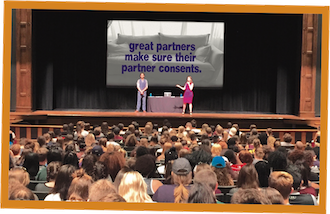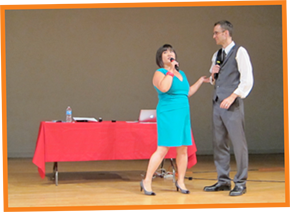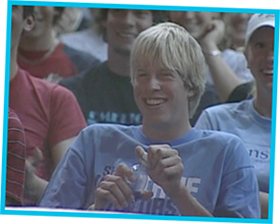college orientation programs
Hot Topics

Designed specifically for first-year Orientation, this engaging, customizable program addresses the topics colleges need their students to understand: consent and sexual violence prevention, the risks of combining drinking and sex, bystander intervention, and more. Students love our humor, honesty, and inclusiveness, while staff are impressed by our willingness to craft a tailored program that incorporates each college’s messaging and priorities. Our friendly, accessible, funny approach engages students while offering them a smarter, healthier, better-informed approach to sexuality and relationships as they begin their time in college.
Customized for the needs of your campus
Our Orientation program has a modular design, allowing us to customize it easily by "sliding in" and "sliding out" educational segments on various topics based on the needs of the college. We have conversations with each school that books it to find out if there are issues of particular concern, and whether there are topics they'd rather not have us a discuss, and then revise our program accordingly to fit with the campus culture and context. We frequently add in college-specific statistics, facts, and resources to our presentations, and welcome key staff (Title IX coordinators, victim advocates, Student Conduct staff, etc) to join us on stage if they wish to introduce themselves briefly and explain their role on campus. We are also happy to work with colleges to give student orientation leaders significant on-stage “teaching roles” if you wish.

Over 3,000 incoming students at Grand Valley State University attend our presentation as part of their orientation.
The program has successfully been tailored for the needs of Catholic colleges, women's schools, and environmental-themed colleges, along with a wide variety of public, private, rural, and urban universities. It works well with audiences of any size -- we've presented to freshman classes ranging in size from 100 to 3,000+, and can do single presentations or a series of back-to-back talks for “round robins” with several sections of the incoming class.
The standard program covers the same topics as our Sex Discussed Here! program:
- consent
- communication in sexual situations
- drinking & sex
- sexual assault prevention
- bystander intervention
- recognizing stalking behaviors and intimate partner violence, compared with healthy relationships and healthy breakups
- communication in sexual situations
- safer sex (including how to use safer sex supplies correctly)
- more detailed information on STI prevention (beyond just teaching how to use safe sex supplies)
- deciding whether to become sexually active
- tips on drinking more safely (harm reduction designed for schools that will not be covering alcohol issues in more depth during another section of Orientation)
- a section on LGBTQ issues with the goal of increasing tolerance and reducing homophobia and transphobia (the entire program is inclusive and non-heteronormative, even without the addition of this module)
- more detailed advice about making abstinence work if that's your choice, and quotes from real students on your campus about why they're choosing abstinence
- pregnancy prevention: strengthening students’ motivation to prevent or delay pregnancy
- new modules created specifically for a college by request
- An emphasis on consent and communication, including specific, real-life tips on how to talk with a partner in ways that don't feel awkward
- A discussion of sexual violence that includes tools for survivors, as well as "great partner" tips about how to handle situations students sometimes find complex or confusing
- An interactive, audience-focused exploration of why some college students drink before they have sex, and the risks and dangers of mixing alcohol and sex
- Validation and support for students choosing abstinence, along with information for those who are sexually active
- Practical facts and tips about how to use condoms and other safer sex supplies correctly in order to reduce HIV and STI transmission (information not taught in most American high schools)
- Humor (at appropriate moments) and audience involvement throughout, to keep students engaged and interested
- Inclusion of the broad diversity of audience members, including students who are gay, lesbian, bisexual, queer, heterosexual; transgender and cisgender; students who are single, in relationships, and married; students who are already living with HIV or another STI; students who are survivors of sexual abuse or sexual assault; students who know a great deal about sexuality and those who grew up in families or communities where the subject wasn't discussed
- Recommended app and website info available to audience members with accurate, in-depth information about contraceptive options and STI symptoms, diagnosis, and treatment
- An underlying message that students should seek the information they need to make safe, healthy, respectful decisions about sexuality


